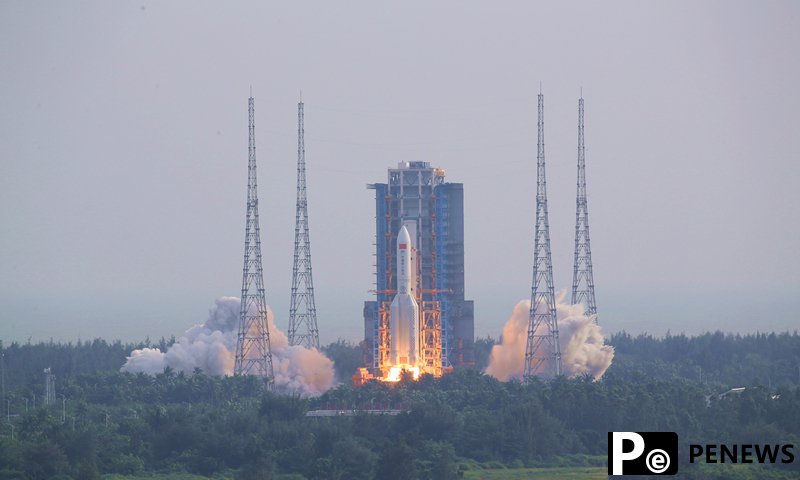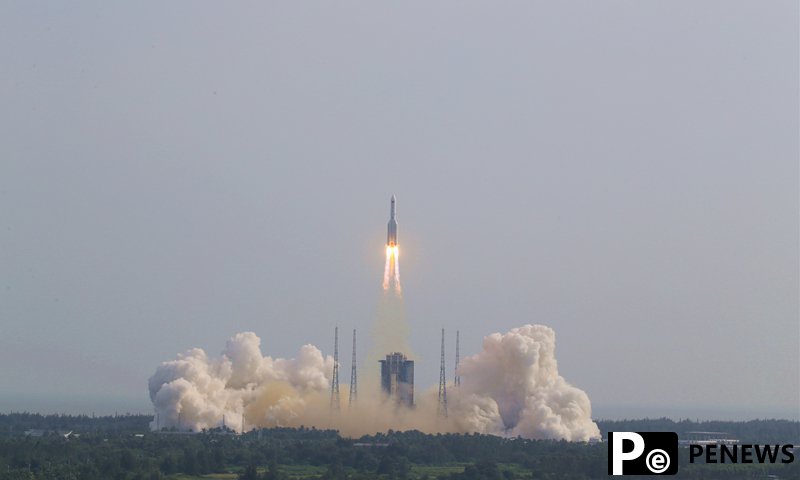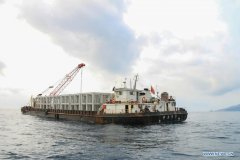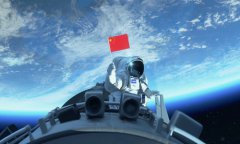Home>>
China successfully launches final part of its three-module space station, to complete T-shape structure assembly(Global Times) 16:09, October 31, 2022

China launches Mengtian lab module via a Long March-5B rocket on Monday afternoon from Wenchang Space Launch Site in South China's tropical island province of Hainan.
China successfully launched Mengtian lab module - the third and final part of its three-module home-developed space station - into preset orbit, on Monday afternoon from South China's tropical island province of Hainan, kicking start the final battle of completing the country's T-shape and first-ever permanent space station.
Mengtian, also the second lab module, will be the last piece before China completes the space station assembly.
Carrying the Mengtian lab module, China's mega Long March-5B Y4 carrier rocket took off from the Wenchang Space Launch Site around xx pm on Monday. And after a flight of around eight minutes, the module separated with the rocket and entered its designated orbit, marking the success of the launch mission, the Global Times learned from the China Manned Space Agency (CMSA).
Following the successful launch, Mengtian will carry out a fast and automated rendezvous and docking with the Tianhe space station core module at the latter's forward docking port, per the CMSA.
The new lab module will then be transpositioned from the forward docking port on Tianhe to the port docking ring on the side, joining the two earlier modules - Tianhe core module and Wentian lab module, to complete the T-shape China Space Station basic structure.
After completing the building of the China Space Station, six taikonauts of two Shenzhou manned spaceflight crew will carry out the first-ever direct handover in orbit.
The powerful Long March-5B carrier rocket has successfully launched all three modules, each weighing over 22 tons at launch, of the China Space Station to date, proving its strength and reliability, the carrier developer the China Academy of Launch Vehicle Technology said in a statement.
The Long March 5B is a one and half stage carrier rocket with four 3.35-meter-diameter liquid propellant boosters, and has a thrust of 1,078 tons by take-off. It is capable of sending payload of 25 tons to the near-Earth orbit.
Huang Bing, the chief designer of the Long March 5 rocket series, told the Global Times that to meet the mission demands of the space station module launch missions, the Long March-5B rocket has made multiple key technology breakthroughs including the separation of the country's largest nose cone at 20.5 meters in length.
The Global Times learned from the Shanghai Academy of Spacecraft Technology (SAST) the developer of the Mengtian module that 17.88-meter-long, 4.2-meter-diameter mega space lab weighs around 23.3 tons by launch, which is the heaviest payload China has ever launched to date.

China launches Mengtian lab module via a Long March-5B rocket on Monday afternoon from Wenchang Space Launch Site in South China's tropical island province of Hainan.
Mengtian module is designed to be a working zone for astronauts and therefore it does not have life support systems like Tianhe and Wentian, nor the dormitory and restrooms. But Mengtian does have installed physical training facility onboard that is similar to the rowing machine on Earth, the SAST introduced.
As the "workshop" for the China Space Station, Mengtian has the most powerful payload supporting capabilities, as it carries 13 standard payload cabinets, hosting experiments mainly in the fields of microgravity scientific studies as well as frontier scientific projects covering fluid physics, combustion and materials science and space technologies.
The Mengtian will carry the world's first space-based set of cold atomic clocks which will include a hydrogen clock, a rubidium clock and an optical clock.
"If successful, the cold atomic clocks will form the most precise time and frequency system in space, which should not lose one second in hundreds of millions of years," said Zhang Wei, director of the Utilization Development Center of Technology and Engineering Center for Space Utilization under the Chinese Academy of Sciences.
The world's first cold atomic clock that operates in space was made by Chinese scientists. It was launched with the Tiangong-2 space lab in 2016, and has a margin of error of less than one second in 30 million years.
Now, through ground-based experiments, Chinese scientists have developed cold atomic clocks that are far more accurate than the Tiangong-2 version, according to Zhang.
The development of space cold atomic clock technology will contribute to higher-precision satellite positioning and navigation, and support fundamental physics research such as dark matter probes and gravitational wave detection, scientists explained.










